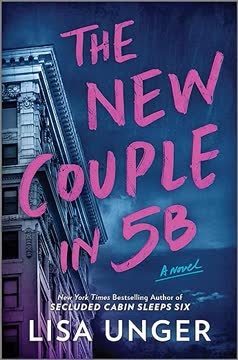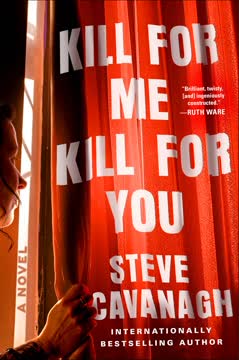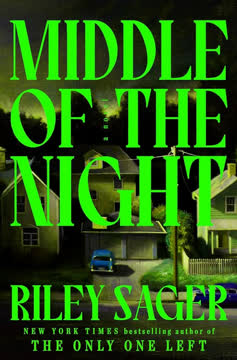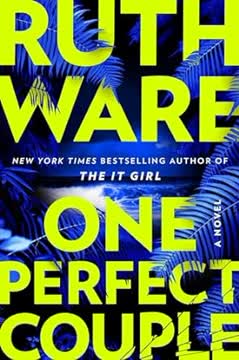Plot Summary
Shadows in the Cottage
In a remote Irish holiday cottage, a woman named Natalie lies asleep, oblivious to the presence of a masked intruder watching her from the shadows. The room is unfamiliar, the night cold and silent. The intruder, dressed in black and armed with a knife, waits for her to wake. When she finally does, terror erupts—her struggle is desperate but futile. The attack is brutal, silent, and methodical, leaving Natalie bleeding and alone. The killer, calm and efficient, destroys a hidden camera before vanishing, erasing evidence but not the horror. This chilling opening sets the tone for a story where safety is an illusion, and the most private spaces can be invaded, watched, and violated. The emotional impact is immediate: fear, helplessness, and the sense that something is deeply, irrevocably wrong.
Natalie's Vanishing Act
Natalie, a popular Instagram influencer, escapes her seemingly perfect Dublin life and husband, Mike, to the isolated Shanamore Cottages. Her journey is driven by suspicion and heartbreak—she's found evidence that Mike may be hiding something, possibly an affair. The rural setting is both a refuge and a source of anxiety, amplifying her sense of isolation. Natalie's unease grows as she discovers personal items from her marriage in the cottage, confirming her fears that Mike has been there with someone else. Her attempts to find peace are undermined by paranoia, the cold, and the sense of being watched. The emotional arc is one of confusion, betrayal, and a desperate need for truth, as Natalie's world unravels in the quiet Irish countryside.
Audrey's Obsession Begins
Audrey, a thirty-year-old entertainment journalist in Dublin, is assigned to cover Natalie's disappearance. Initially, it's just another click-driven assignment, but Audrey becomes personally invested, drawn to the mystery and the contrast between Natalie's glossy online persona and her sudden, unexplained absence. Audrey's own life is in turmoil—her job is precarious, her living situation unstable, and she's desperate for a breakthrough. As she investigates, she uncovers inconsistencies in Natalie's social media and the timeline of her disappearance. Audrey's determination grows, fueled by professional ambition and empathy for Natalie. The emotional tone is restless and hungry, as Audrey senses that this story could change everything for both her and the missing woman.
The Man Behind the Screen
Andrew, the manager of Shanamore Cottages, is a solitary, awkward man with a troubled past. He secretly records guests through hidden cameras, rationalizing it as security but driven by darker compulsions and blackmail. When he witnesses Natalie's murder via his own camera feed, he is paralyzed by fear and guilt. Instead of calling the police, he tries to cover up the crime, cleaning the scene and disposing of evidence. Andrew's actions are shaped by years of loneliness, shame, and manipulation by unseen forces. His psychological torment is palpable—he is both victim and perpetrator, trapped in a cycle of voyeurism and self-loathing. The emotional impact is claustrophobic and tense, as Andrew's world closes in around him.
The Stranger at the Window
Alone in the cottage, Natalie becomes increasingly unsettled by the sense of being watched. Encounters with Richard, a creepy local handyman, and glimpses of a mysterious woman in Andrew's window heighten her anxiety. She finds a threatening note—"LEAVE"—and realizes her phone is dead, cutting her off from help. Natalie's attempts to seek answers from Andrew and the villagers are met with evasions and lies. Her fear escalates into panic as she feels hunted, not just by her husband's secrets but by something more sinister lurking in Shanamore. The emotional arc is one of mounting dread, as Natalie's isolation becomes both physical and psychological, and her trust in her own perceptions begins to erode.
The Note and the Book
Natalie's discovery of a book from her marriage in the cottage, and a threatening note on the fridge, become the focal points of her unraveling reality. She confronts Andrew, who denies everything, and begins to doubt her own sanity. The line between paranoia and genuine threat blurs as Natalie questions whether she's being manipulated by Mike, Andrew, or her own mind. The emotional tone is fraught with confusion, vulnerability, and the desperate need for validation. Natalie's sense of self is under siege, and the cottage becomes a crucible for her fears and suspicions, pushing her to the brink.
The Village of Secrets
Audrey arrives in Shanamore, following leads that place Natalie in the village after her disappearance. She interviews locals, including Orla, a café worker who confirms seeing Natalie and hints at the village's insular, gossipy nature. Audrey's investigation reveals a web of secrets: Andrew's odd behavior, Richard's lurking presence, and the villagers' reluctance to talk. The setting is claustrophobic, with the cottages, pub, and beach forming a closed circuit of suspicion. Audrey's outsider status makes her both a threat and a target, as she uncovers layers of deception and denial. The emotional arc is one of determination and growing unease, as Audrey realizes the village itself is complicit in hiding the truth.
The Reporter and the Husband
Audrey's interview with Mike, Natalie's husband, is tense and evasive. Mike is defensive, reluctant to share details, and possibly hiding something. Audrey senses that the marriage was troubled, and that Mike's delay in reporting Natalie missing is suspicious. She uncovers evidence of a credit card charge at Shanamore Cottages, which Mike denies knowledge of. The encounter leaves Audrey with more questions than answers, but also a sense that the case is more complex than a simple domestic dispute. The emotional tone is one of frustration and suspicion, as Audrey pushes against the walls of secrecy surrounding Natalie's disappearance.
The Woman in Black Glasses
Jennifer, the owner of a Dublin guesthouse, is revealed as Mike's secret lover and the story's true antagonist. Obsessed with Mike and resentful of Natalie, Jennifer orchestrates a campaign of psychological terror—stalking, gaslighting, and ultimately murder. She manipulates Andrew into installing cameras, blackmails him with footage of his own crimes, and engineers Natalie's journey to Shanamore. Jennifer's perspective is chillingly rational, her actions driven by entitlement and a warped sense of justice. The emotional impact is one of horror and fascination, as the narrative exposes the mind of a woman who will do anything to possess the life she believes she deserves.
The Camera's Hidden Eye
The hidden cameras in Shanamore Cottages are both literal and symbolic—tools of surveillance, control, and violation. Andrew's recordings are used to blackmail him, and ultimately to document Natalie's murder. The footage becomes a key piece of evidence, sent anonymously to Audrey and the police. The theme of being watched permeates the story, blurring the boundaries between victim and perpetrator, observer and observed. The emotional tone is invasive and unsettling, as the characters' most private moments are exposed and exploited, and the truth is revealed through the lens of a hidden eye.
The Body on the Beach
Natalie's body washes up on the beach, confirming the worst fears of Audrey, Mike, and the police. The discovery is both a climax and a turning point—transforming the case from a missing person to a murder investigation. The village is thrown into chaos, and suspicion falls on Andrew and Richard. Audrey, traumatized by the video of the murder, becomes both witness and investigator, piecing together the final hours of Natalie's life. The emotional impact is devastating, as the reality of violence shatters the illusions of safety and control that once defined the characters' lives.
The Truth Unravels
As the investigation intensifies, Audrey and the police uncover the full extent of Jennifer's manipulation. Evidence mounts: the credit card fraud, the staged bill, the psychological warfare waged against Natalie, and the orchestration of her murder. Andrew confesses to moving the body and cleaning the scene, but insists he is not the killer. The hidden camera footage, when analyzed, reveals that the murderer is not a man, but a woman—Jennifer, disguised and methodical. The emotional arc is one of revelation and catharsis, as the web of lies is finally untangled and justice begins to take shape.
The Other Woman's Game
Jennifer's motivations and methods are laid bare—her obsession with Mike, her jealousy of Natalie, and her willingness to manipulate, blackmail, and kill to achieve her goals. She exploits Andrew's weaknesses, orchestrates Natalie's journey to Shanamore, and ensures that all evidence points away from herself. Jennifer's psychological profile is complex: she is both predator and victim, shaped by loneliness, entitlement, and a profound lack of empathy. Her eventual exposure is both satisfying and tragic, as the consequences of her actions ripple through the lives of everyone involved.
The Web of Voyeurism
The story's central plot device—the hidden cameras—serves as a metaphor for the dangers of surveillance, social media, and the erosion of privacy. Jennifer's guesthouse is revealed to be a hub for voyeuristic exploitation, and Andrew's recordings are part of a larger network of blackmail and abuse. The digital evidence becomes the key to solving the crime, but also a reminder of how easily lives can be invaded and destroyed. The emotional tone is one of violation and exposure, as the characters grapple with the consequences of being watched, recorded, and judged.
The Final Rewind
With Jennifer arrested and Andrew facing charges for his own crimes, the story moves into its aftermath. Audrey, now recognized for her investigative work, reflects on the case's impact—on herself, the village, and the wider world. The narrative rewinds to the beginning, examining the small decisions and chance encounters that led to tragedy. The emotional arc is one of closure and reckoning, as the characters confront the truth and begin to heal. The story ends with a sense of hard-won clarity, but also a lingering unease about the darkness that can hide behind ordinary lives.
Aftermath and Exposure
In the wake of the investigation, the characters' lives are irrevocably altered. Audrey's career is transformed, but she is haunted by what she has witnessed. Mike is left to grieve and rebuild, his illusions shattered. The village of Shanamore is marked by scandal and loss, its secrets exposed to the world. Jennifer faces a life sentence, her fantasies destroyed by reality. The story closes with a meditation on the dangers of obsession, the fragility of privacy, and the power of truth to both wound and heal. The emotional tone is somber but hopeful, as the survivors seek meaning in the ruins of what was lost.
Characters
Natalie O'Connor
Natalie is the emotional heart of the story—a woman whose carefully curated online life masks deep insecurities and growing suspicions about her marriage. Her journey from Dublin to Shanamore is driven by a need for truth and self-preservation, as she seeks to uncover her husband's secrets and reclaim her sense of agency. Natalie's vulnerability is palpable; she is both victim and detective, navigating a world where appearances deceive and trust is fragile. Her psychological unraveling is both tragic and relatable, as she confronts gaslighting, isolation, and the ultimate violation of her privacy and safety.
Audrey Coughlan
Audrey is a struggling journalist whose professional and personal lives are in flux. Her initial assignment to cover Natalie's disappearance becomes an obsession, as she is drawn into the mystery and the emotional stakes of the case. Audrey's intelligence, empathy, and determination drive the investigation forward, even as she battles self-doubt and institutional resistance. Her outsider status allows her to see what others miss, and her willingness to break rules is both her strength and her vulnerability. Audrey's arc is one of growth and self-discovery, as she transforms from a passive observer to an active agent of truth.
Andrew Gallagher
Andrew is the manager of Shanamore Cottages, a man marked by loneliness, trauma, and a history of inappropriate desires. Blackmailed into installing hidden cameras, he becomes both perpetrator and victim, complicit in the violation of his guests' privacy but also trapped by forces beyond his control. Andrew's psychological profile is complex—he is driven by shame, fear, and a desperate need for connection. His actions are shaped by manipulation and self-loathing, and his eventual confession is both a plea for help and an admission of guilt. Andrew embodies the story's themes of surveillance, secrecy, and the corrosive power of shame.
Jennifer Blake
Jennifer is the story's antagonist—a woman whose obsession with Mike, Natalie's husband, drives her to orchestrate a campaign of psychological terror and murder. As the owner of a guesthouse, she exploits her position to record and blackmail guests, and her intelligence and cunning make her a formidable adversary. Jennifer's motivations are rooted in entitlement, jealousy, and a profound lack of empathy. Her psychological unraveling is chilling, as she rationalizes her actions and manipulates those around her. Jennifer's downfall is both inevitable and tragic, a testament to the destructive power of obsession.
Mike Kerr
Mike is Natalie's husband, a successful professional whose marriage is unraveling beneath the surface. His emotional distance, evasiveness, and possible infidelity make him a figure of suspicion, both for Natalie and the reader. Mike's relationship with Jennifer is the catalyst for the story's central tragedy, and his inability to confront the truth leads to devastating consequences. Psychologically, Mike is conflicted—torn between loyalty, guilt, and self-preservation. His arc is one of reckoning, as he is forced to confront the reality of his actions and their impact on those he loves.
Richard Flynn
Richard is a local handyman and self-styled artist, known in the village as "Icky Dickie." His invasive behavior and ambiguous motives make him both a suspect and a red herring. Richard's outsider status and resentment toward Andrew add layers of complexity to the investigation. Psychologically, he is manipulative, opportunistic, and driven by a need for recognition and control. His role in discovering Natalie's body and interacting with Audrey adds tension and ambiguity to the narrative, as his true intentions remain unclear until the end.
Orla Sheridan
Orla is a young woman who works at The Kiln café in Shanamore. She is one of the few locals willing to talk to Audrey, providing crucial information about Natalie's presence in the village. Orla's perspective is shaped by small-town gossip, loyalty, and a desire to help, but she is also wary of getting too involved. Psychologically, Orla is empathetic but cautious, aware of the dangers of speaking out in a community that values secrecy. Her role as a bridge between the village and the outside world is vital to the investigation.
Sergeant Seanie Flynn
Seanie is the village's police sergeant, a man with deep roots in Shanamore and a complicated history with Andrew. His investigation is shaped by personal memories, professional duty, and a desire to protect his community. Seanie's psychological profile is marked by guilt, regret, and a need for redemption, particularly in relation to past failures. His interactions with Audrey and the other characters reveal the challenges of policing in a close-knit, secretive environment. Seanie's arc is one of growth and accountability, as he confronts the darkness within his own past and the village he serves.
Carla
Carla is Natalie's childhood friend, a grounded and pragmatic presence in contrast to Natalie's online persona. She is supportive but skeptical of Natalie's influencer lifestyle, and her perspective provides a counterpoint to the story's themes of image and reality. Psychologically, Carla is loyal, honest, and protective, but also frustrated by Natalie's choices and the distance that has grown between them. Her role is to humanize Natalie, reminding the reader of the person behind the persona, and to highlight the costs of living a life curated for public consumption.
Sandra Cotter
Sandra is a veteran journalist who becomes Audrey's ally and mentor as the investigation unfolds. Her experience, pragmatism, and willingness to "send the elevator back down" help Audrey navigate the complexities of the case and the media landscape. Psychologically, Sandra is tough, resourceful, and driven by a commitment to truth and justice. Her presence provides stability and perspective, grounding the story's more sensational elements in the realities of investigative journalism.
Plot Devices
Hidden Cameras and Voyeurism
The use of hidden cameras in Shanamore Cottages is the story's central plot device, serving as both a tool of blackmail and the means by which the murder is witnessed and ultimately solved. The cameras symbolize the erosion of privacy in the digital age, the dangers of surveillance, and the ease with which lives can be invaded and destroyed. The footage captured becomes the key piece of evidence, driving the investigation and exposing the truth. The device also serves as a metaphor for the story's themes of observation, judgment, and the blurred boundaries between victim and perpetrator.
Unreliable Narrators and Gaslighting
The narrative is shaped by characters who are unreliable—either because they are lying, being lied to, or doubting their own perceptions. Natalie's experience of gaslighting, both by Mike and by the events in Shanamore, creates a sense of disorientation and vulnerability. The shifting perspectives and incomplete information force the reader to question what is real and who can be trusted. This device heightens suspense and emotional engagement, as the truth is revealed in fragments and the line between paranoia and genuine threat is constantly blurred.
Social Media and Public Persona
The contrast between Natalie's Instagram-perfect life and her private struggles is a recurring motif. Social media serves as both a shield and a weapon—protecting Natalie from scrutiny while also exposing her to envy, judgment, and danger. The story explores the psychological toll of living a life curated for public consumption, the pressures of maintaining an image, and the ways in which online personas can mask deep unhappiness and vulnerability. This device grounds the narrative in contemporary anxieties about authenticity, privacy, and the costs of digital fame.
Small-Town Insularity and Secrecy
The setting of Shanamore—a remote, insular village—serves as both a character and a plot device. The village's culture of secrecy, gossip, and resistance to outsiders creates obstacles for Audrey and the investigation. The close-knit community is both protective and complicit, hiding truths and enabling wrongdoing. This device amplifies the story's themes of isolation, complicity, and the dangers of looking the other way. The village becomes a microcosm of larger societal issues, where darkness can thrive behind closed doors.
Multiple Perspectives and Nonlinear Structure
The narrative unfolds through multiple points of view—Natalie, Audrey, Andrew, Jennifer, and others—allowing the reader to piece together the truth from different angles. The use of flashbacks, emails, and video footage creates a nonlinear structure that mirrors the process of investigation and discovery. This device builds suspense, deepens character development, and allows for dramatic irony, as the reader often knows more than the characters themselves. The structure reinforces the story's themes of perception, memory, and the search for truth.
Analysis
Catherine Ryan Howard's Rewind is a masterful exploration of the dangers lurking beneath the surface of modern life—where privacy is an illusion, and the boundaries between public and private, victim and perpetrator, are constantly shifting. The novel interrogates the psychological toll of living in a world saturated with surveillance, social media, and curated personas. Through its intricate plot and deeply flawed characters, Rewind exposes the ways in which obsession, loneliness, and entitlement can metastasize into violence and exploitation. The story's use of hidden cameras as both literal and metaphorical devices underscores the vulnerability of even the most seemingly secure lives. The novel's nonlinear structure and multiple perspectives invite the reader to question their own assumptions, mirroring the characters' struggles to discern truth from deception. Ultimately, Rewind is a cautionary tale about the costs of looking away, the dangers of unchecked desire, and the power of truth to both destroy and redeem. Its lessons are urgent and unsettling: in a world where everyone is watching, no one is truly safe—and the most dangerous threats may come from those closest to us.
Last updated:
Review Summary
Rewind received mixed reviews, with many praising its clever structure and creepy atmosphere. Readers appreciated the unique storytelling format using rewind, pause, and fast-forward chapters. The plot, involving a murder caught on camera at a remote Irish cottage, intrigued most readers. Some found the multiple timelines and characters confusing, while others enjoyed piecing together the mystery. The book's exploration of social media dangers and voyeurism resonated with many. Overall, it was seen as a fast-paced, suspenseful thriller, though some felt the ending fell flat.
Similar Books
Download PDF
Download EPUB
.epub digital book format is ideal for reading ebooks on phones, tablets, and e-readers.















